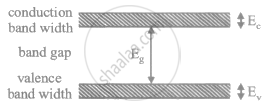Advertisements
Advertisements
Question
Calculate the number of states per cubic metre of sodium in 3s band. The density of sodium is 1013 kgm−3. How many of them are empty?
Solution
Density of sodium, d = 1013 \[\text{ kg/ m}^3\]
Volume, V = 1m3
We know that 23 g sodium contains 6 atoms, so the number of atoms in 1023 kg sodium will be
\[\frac{1013 \times {10}^3 \times 6 \times {10}^{23}}{23}\]
\[ = \left( \frac{1013 \times 6}{23} \right) \times {10}^{26} \]
\[ = 264 . 26 \times {10}^{26}\]
(a) As the number of maximum possible electrons that can occupy the 3s band is 2, the total number of states in the 3s band will be
\[N = 2 \times 264 . 26 \times {10}^{26} \]
\[ = 528 . 52 \times {10}^{26} \approx 5 . 3 \times {10}^{28}\]
(b) As the atomic number of sodium is 11, its electronic configuration is \[1 s^2 , 2 s^2 , 2 p^6 , 3 s^1\] .
This implies that the 3s band is half-filled in case of sodium, so the total number of unoccupied states is 2.65 × 1028.
APPEARS IN
RELATED QUESTIONS
Draw separate energy band diagram for conductors, semiconductors and insulators and
label each of them.
The conduction band of a solid is partially filled at 0 K. Will it be a conductor, a semiconductor or an insulator?
What is the resistance of an intrinsic semiconductor at 0 K?
Electric conduction in a semiconductor takes place due to
An electric field is applied to a semiconductor. Let the number of charge carries be nand the average drift speed by v. If the temperature is increased,
A p-type semiconductor is
An incomplete sentence about transistors is given below:
The emitter−..... junction is __ and the collector−..... junction is __. The appropriate words for the dotted empty positions are, respectively,
In a semiconductor,
(a) there are no free electrons at 0 K
(b) there are no free electrons at any temperature
(c) the number of free electrons increases with temperature
(d) the number of free electrons is less than that in a conductor.
Indium antimonide has a band gap of 0.23 eV between the valence and the conduction band. Find the temperature at which kT equals the band gap.
The conductivity of a pure semiconductor is roughly proportional to T3/2 e−ΔE/2kT where ΔE is the band gap. The band gap for germanium is 0.74 eV at 4 K and 0.67 eV at 300 K. By what factor does the conductivity of pure germanium increase as the temperature is raised from 4 K to 300 K?
Estimate the proportion of boron impurity which will increase the conductivity of a pure silicon sample by a factor of 100. Assume that each boron atom creates a hole and the concentration of holes in pure silicon at the same temperature is 7 × 1015 holes per cubic metre. Density of silicon 5 × 1028 atoms per cubic metre.
A semiconducting material has a band gap of 1 eV. Acceptor impurities are doped into it which create acceptor levels 1 meV above the valence band. Assume that the transition from one energy level to the other is almost forbidden if kT is less than 1/50 of the energy gap. Also if kT is more than twice the gap, the upper levels have maximum population. The temperature of the semiconductor is increased from 0 K. The concentration of the holes increases with temperature and after a certain temperature it becomes approximately constant. As the temperature is further increased, the hole concentration again starts increasing at a certain temperature. Find the order of the temperature range in which the hole concentration remains approximately constant.
(Use Planck constant h = 4.14 × 10-15 eV-s, Boltzmann constant k = 8·62 × 10-5 eV/K.)
If the lattice constant of this semiconductor is decreased, then which of the following is correct?

The energy of a hydrogen atom in the ground state is −13.6 eV. The energy of a He+ ion in the first excited state will be:
An n-type semiconductor is
The valance of an impurity added to germanium crystal in order to convert it into p-type semiconductor is
In a common base configuration Ie = 1 mA α = 0.95 the value of base current is
The energy required by an electron to jump the forbidden band in silicon at room temperature is about ______.
